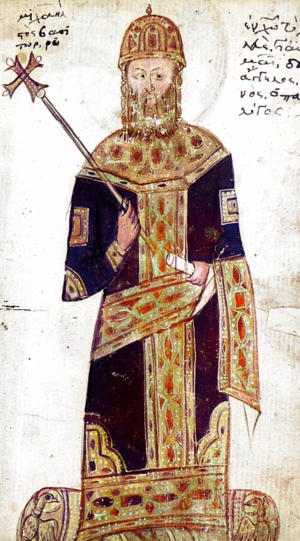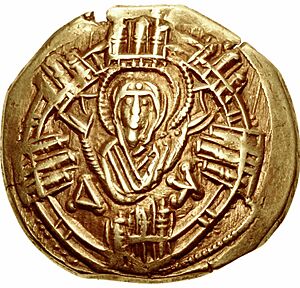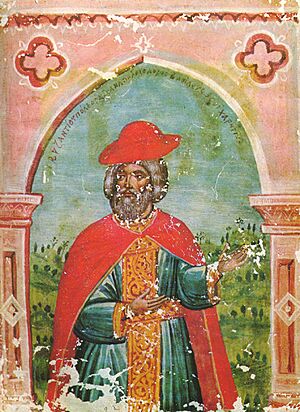Michael VIII Palaiologos facts for kids
Quick facts for kids Michael VIII Palaiologos |
|
|---|---|
| Emperor and Autocrat of the Romans | |

Miniature portrait in a manuscript of George Pachymeres' Historia, early 14th century
|
|
| Byzantine emperor | |
| Reign | 15 August 1261 – 11 December 1282 |
| Predecessor | Baldwin II (Latin Empire) |
| Successor | Andronikos II Palaiologos |
| Emperor of Nicaea | |
| Reign | 1 January 1259 – 15 August 1261 |
| Predecessor | John IV Laskaris |
| Successor | Byzantine Empire restored |
| Born | 1224 Empire of Nicaea |
| Died | 11 December 1282 (aged 58) Pachomion, near Lysimachia, Byzantine Empire |
| Spouse | Theodora Palaiologina |
| Issue more... |
|
| Dynasty | Palaiologos |
| Father | Andronikos Komnenos Palaiologos |
| Mother | Theodora Angelina Palaiologina |
| Religion | Orthodox |
Michael VIII Palaiologos (1224 – 11 December 1282) was a powerful Byzantine emperor. He ruled the Byzantine Empire from 1261 until his death. Before that, he was a co-emperor of the Empire of Nicaea from 1259 to 1261.
Michael VIII started the Palaiologan family line. This family ruled the Byzantine Empire for a very long time, until 1453. He is famous for taking back Constantinople in 1261. This city was the capital of the Byzantine Empire.
His rule brought back much of the Byzantine Empire's strength. He made the Byzantine army and navy bigger. He also rebuilt Constantinople and helped its population grow. He even reopened the University of Constantinople. This led to a time of great art and learning called the Palaeologan Renaissance.
However, Michael also focused more on fighting in Europe. This meant less attention was given to the borders in Asia. Later leaders struggled with this, and the empire became weaker. This led to new groups like the Ottoman Empire taking over more land.
Contents
Early Life of Michael VIII
Michael VIII Palaiologos was the son of Andronikos Palaiologos. His mother was Theodora Angelina Palaiologina. She was the granddaughter of Emperor Alexios III Angelos.
Historians say Michael's family was connected to all three royal families. These families ruled the Byzantine Empire before 1204. His older sister, Martha, helped raise him.
How Michael Rose to Power
Michael became important at a young age. He was a governor in Thracian towns like Melnik and Serres. In 1253, some people accused him of plotting against Emperor John III Vatatzes.
Michael avoided punishment by being clever. He was later married to the Emperor's grandniece. He also became a commander of Latin soldiers. But people still did not fully trust him.
After Emperor John Vatatzes died, Michael left and worked for the Seljuk Sultanate of Rum. He led Christian soldiers from 1256 to 1258. Then, Emperor Theodore II Laskaris called him back. They promised to be loyal to each other.
In 1258, Emperor Theodore Laskaris died. Michael Palaiologos then took control. He became the guardian of the young Emperor John IV Laskaris. On January 1, 1259, Michael was officially named emperor. This happened in Nymphaion.
Taking Back Constantinople
In 1259, Michael VIII won a big battle. It was the Battle of Pelagonia. He defeated an alliance of enemies from the west. This victory made Michael seem like a strong leader. It also helped him gain more support.
But Michael knew he needed to do one more thing. He had to take back Constantinople. In 1260, he tried to capture the city but failed. He then signed a truce with the Latin Emperor Baldwin II.
Michael realized he needed a strong navy. So, he made a deal with Genoa in 1261. But Genoa's help was not needed. Michael VIII's general, Alexios Strategopoulos, captured Constantinople on July 25, 1261. He used a clever trick to get inside the city.
Michael VIII entered Constantinople on August 15. He was crowned emperor there. He removed all Latin customs and brought back Byzantine traditions. He also worked to rebuild the city. Its population grew from 35,000 to 70,000 people. He repaired churches and public buildings.
Michael was worried that Western countries would try to take Constantinople again. He knew they might want to bring back Latin rule.
John IV, the young emperor, was still in Nicaea. Michael had him blinded in December 1261. This made John unable to rule. Michael then married John's sisters to powerful nobles. This was to protect his own children's claim to the throne. The news of John's blinding eventually spread. The church leader, Patriarch Arsenios Autoreianos, punished Michael for this.
Diplomacy and Military Actions

After taking Constantinople, Michael wanted to improve relations with the Pope. He sent messengers to Pope Urban IV. But these messengers were captured and killed.
Michael also tried to make a deal with Manfred of Sicily. He even offered to divorce his wife and marry Manfred's sister. But this plan failed. His wife, Theodora, and the Patriarch stopped him.
Michael faced problems in his eastern lands. Nomadic Turkmen groups began moving into Byzantine areas. Michael was busy fighting in the West. So, he could not fully deal with this threat.
There were also military losses. In 1263, Michael sent 15,000 soldiers to Morea. They wanted to conquer the Principality of Achaea. But this army was defeated at Prinitza. Later, a Byzantine and Genoese fleet lost to a smaller Venetian force.
In 1265, Michael himself was almost captured. An army of Tatars and Bulgars attacked him in Thrace. He escaped by finding two Latin ships and sailing to Constantinople.
After these losses, Michael used his diplomatic skills. He made a secret agreement with Venice. He also signed a treaty in 1263 with the Egyptian Mamluk sultan Baibars.
Michael and Charles of Anjou
A new enemy appeared in 1266: Charles of Anjou. He was a powerful king from Sicily. Michael spent most of his reign trying to stop Charles. Charles wanted to conquer Constantinople and bring back Latin rule.
In 1267, Charles made a deal with the exiled Emperor Baldwin II. This deal, called the Treaty of Viterbo, aimed to take Constantinople.
Michael and Charles were very similar. Both were ambitious and good at planning. A historian named Nicephorus Gregoras said that if either of them had not been in charge, the other would have won easily.
Michael also faced problems in Asia. Turkish groups continued to move into Byzantine lands. The Byzantine army was not strong enough to stop them. Many Greek people in these areas were unhappy with Michael.
To counter Charles, Michael tried to get the Pope's support. He wanted to unite the Eastern and Western churches. This would make it harder for the Pope to support Charles's invasion. Pope Clement IV died, which paused these talks.
Michael also asked King Louis IX of France for help. Louis was Charles's older brother. Louis was more interested in a crusade against Muslims. So, he made Charles join his crusade in 1270. A big storm later destroyed Charles's fleet. This was a lucky break for Michael.
After a few years, a new Pope, Gregory X, was elected. Michael restarted talks about church union. He had to remove the Patriarch Joseph and replace him with John Bekkos. This was to get the church to agree to the union.
Church Union and Its Challenges

Byzantine messengers went to the Second Council of Lyon in 1274. They presented letters from Michael and his son. On June 24, 1274, the churches formally reunited. For the first time in 200 years, Eastern and Western Christianity were together.
This union helped Michael greatly. It made his rule in Constantinople seem more rightful. It also stopped Charles from getting the Pope's full support for an invasion. Pope Gregory was even open to a crusade against the Turks. But these plans stopped when Gregory died in 1276.
The news of the union caused problems back home. Many people, especially monks, were against it. Michael's own sister, Eulogia, opposed him. She even tried to plot against him.
The sons of Michael of Epirus also opposed the union. They claimed to be defenders of the Orthodox faith. Michael first tried to persuade those against the union. But their protests became too strong. He then used force. Many people were blinded or sent away. Even imperial officials were punished.
The religious problems made things worse for Michael. Many unhappy people in Asia joined the anti-union side. This led to soldiers leaving the army or joining the Turks. Some cities like Antioch on the Maeander were lost to the Turks.
In 1277, a church meeting in Neopatras declared Michael a heretic. In response, Michael's church meeting in Constantinople declared his enemies heretics.
Michael's military actions had mixed results. He tried to take advantage of a civil war in Bulgaria. But his armies lost several battles. He did manage to gain some Bulgarian land.
In 1275, Michael sent an army to Thessaly. They were badly defeated. But his navy won a big victory at sea.
His biggest victory was against Charles of Anjou in Greece. Charles's general, Hugh of Sully, attacked Berat in 1280. A Byzantine army arrived in 1281. Hugh of Sully was captured, and his army was defeated. This victory stopped Charles's land attack on Constantinople.
The Sicilian Vespers

In 1281, a new Pope, Pope Martin IV, was chosen. He was very loyal to Charles of Anjou. The Pope quickly punished Michael, ending the church union.
Charles prepared a huge army and navy to attack Constantinople. He had hundreds of ships and thousands of soldiers. Many powerful groups were allied with Charles. These included the Kings of France and Hungary, and Venice.
Michael needed allies against Charles. He found few. He talked to the Sultan of Egypt and the Tatars. He also found a friend in King Peter III of Aragon. Peter's wife was the daughter of Manfred, whom Charles had defeated. So, Peter saw Charles as a usurper.
Before Charles could attack Constantinople, a rebellion broke out. It was called the Sicilian Vespers. This happened on March 30, 1282, in Sicily. Charles had to send his forces to deal with this revolt. Many of his ships were destroyed. Peter of Aragon then landed in Sicily and claimed the island.
Many people believed Michael started this rebellion. Historians say Michael was in contact with the rebel leaders. But they also say he was not directly involved in the first incident.
Michael also helped cause revolts in Crete against the Venetians. These revolts hurt Venice's trade. Michael wanted to force Venice, an ally of Charles, to negotiate with him.
Death and What He Left Behind
Michael VIII died in a village in Thrace on December 11, 1282. He was not buried in Constantinople. This was because of his actions against the church regarding the union with Rome. He was buried in a monastery. Later, his body was moved to another monastery in Selymbria.
Michael VIII rebuilt the Byzantine Empire's government. But he did not fix its weaknesses. He focused on defending Europe. This meant he took soldiers away from the borders in Asia. He also lowered their pay. This made the Asian borders weaker. Turkish groups began to move in even before he died.
The Palaiologan family, which Michael started, ruled the Byzantine Empire for almost 200 years. This was longer than any other family in Roman history. During his rule, the Byzantine navy also grew to 80 ships.
Family
In 1253, Michael VIII Palaiologos married Theodora Palaiologina. She was a grandniece of Emperor John III Doukas Vatatzes. John III loved her like a daughter and arranged her marriage to Michael.
Their children were:
- Manuel Palaiologos (born around 1255)
- Irene Palaiologina (born around 1256), who married Emperor Ivan Asen III of Bulgaria
- Andronikos II Palaiologos (1259–1332), who became Byzantine emperor
- Anna Palaiologina (born around 1260), who married Demetrios/Michael Komnenos Doukas
- Constantine Palaiologos (1261–1306)
- Theodora Palaiologina, who married King David VI of Georgia
- Eudokia Palaiologina, who married Emperor John II of Trebizond
- Theodore Palaiologos (born around 1263)
Michael VIII also had two daughters with another woman:
- Euphrosyne Palaiologina, who married Nogai Khan
- Maria Palaiologina, who married Abaqa Khan
See also
 In Spanish: Miguel VIII Paleólogo para niños
In Spanish: Miguel VIII Paleólogo para niños



